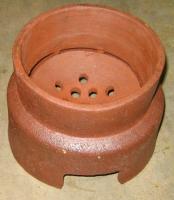Crispin Pemberton‐Pigott October, 2008
Sustainable Energy Technology and Research Centre University of Johannesbrg
Programme for Basic Energy Conservation GTZ/ProBEC a SADC Regional Project
See the attached pdf: CERAMIC DEVELOPMENT FOR DOMESTIC STOVES
Also take a look at Crispin's very good ceramic stove image galleries.
It is intended that this brief report describe in an accessible manner the results of some basic research into the performance of ceramic materials suitable for use to make modern, low‐cost improved charcoal stoves. The
theatre of investigation is the area around Maputo, Moçambique.
The information and ideas are assembled from a large number of tests and reports. If studied carefully an understanding can be gained of the
principle ingredients found in typical clays. It is hoped enough can also
be learned about what the tests show so as to interest the ‘stover’ in a
deeper study of this vast subject.
Some reasons why clay stoves and stove components typically have such a
short life are described and to a certain extent, what can be done about
it.
There is a great deal of material available on how to find, identify and
process clays such as pottery books and the internet. It is not repeated
here. Unfortunately very little of the material available is geared to
the design of low cost ceramics stoves which have problems not encountered
in many industrial applications with far higher temperatures.
Ceramics are complex mixtures of many minerals so it is not possible to
give comprehensive explanations in such a brief text, however the novice
reader should learn enough to be able to deal with a laboratory and
understand some common terminology and the test results. There have been
many technological advances in recent years making accessible tests and
analyses that were previously unaffordable to the ordinary potter.

